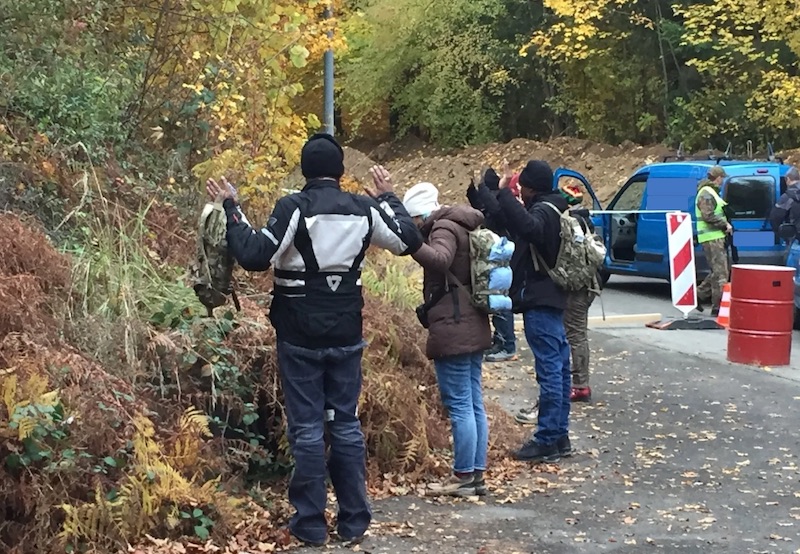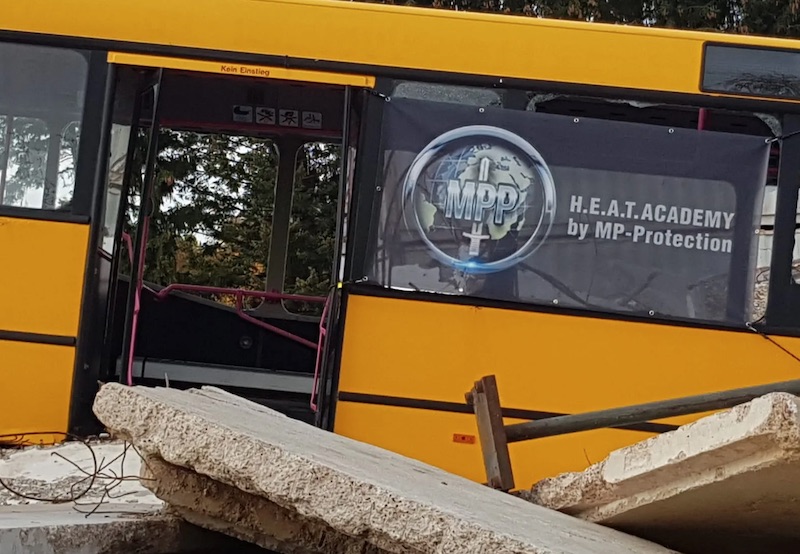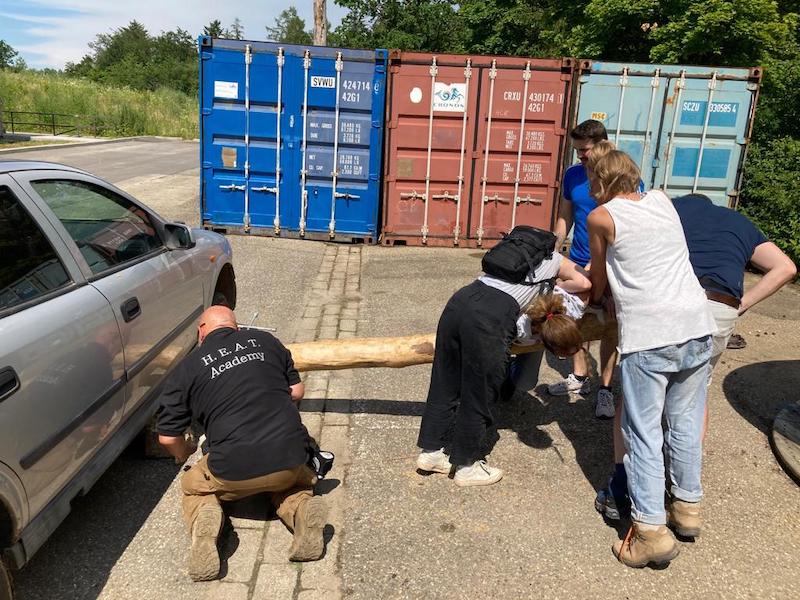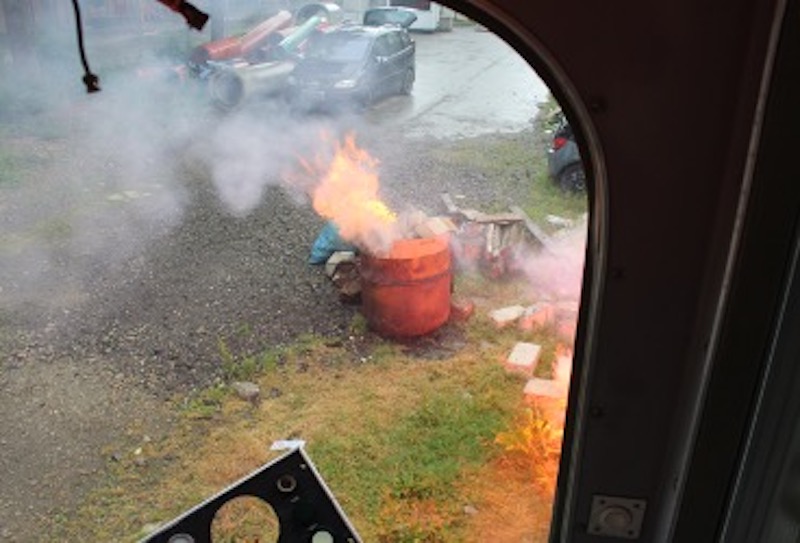Get the weekly SPARTANAT newsletter.
Your bonus: the free E-Book from SPARTANAT.

Being kidnapped once? Wiebke Köhler is a top management consultant and she has had the experience. Here is her report on "something completely crazy", a special training that leads to extreme situations: Recently I attended a HEAT course, conducted by the H.E.A.T. Akademie in Mosbach, Baden-Württemberg. HEAT stands for Hostile Environment Awareness Training. The name lives up to its promise.
Exponential Stress Resistance
The courses held in Mosbach focus on mastering or simply surviving shock events in a high-risk environment. No, this is not a metaphorical description of a normal day at the office in management - although the training also provides outstanding resilience for that - it is meant quite literally. A shock event in civilian life could be a mass car accident on the highway, a fire in a hotel, a knife attack in a pedestrian zone, an explosion of a truck.
As I said: Anyone who has completed a HEAT training handles such disasters more confidently and survives - well-prepared. That is the transfer of training to everyday life. But that is just a welcome side effect. Because the training is actually intended for something completely different.
High-Risk Environment
HEAT courses are mainly attended by foreign journalists sent to unsafe countries, by teachers before they will teach at German schools abroad, by government organizations and agencies as well as private companies. Because in the countries they are sent to, for example, in case of a breakdown, you can't just call roadside assistance. Because firstly, there is no roadside assistance there, and secondly, even if there were, they would not come if the driver risks being kidnapped.
Such training is HEAT. It prepares you for the worst you could encounter in certain countries. It does not show how to behave in escalated crisis or even war situations, as it is not a military training. But it sensitizes every civilian to hostile environments. It shows you how to move as safely and as confidently as possible even in unstable countries with high security risks, for example in countries like Afghanistan, Iraq, or the West Bank.
We complain about traffic jams, others have mines
Therefore, HEAT also includes dealing with possible mine danger, safely passing through legal and illegal checkpoints with militias whose trigger finger may itch, as well as the possibility of suddenly facing a gun barrel on the street and being robbed or taken hostage.
Due to an increasingly uncertain environment, such courses are also recommended for us here in Germany, if we want to prepare for the unexpected or need to for professional reasons. This includes on one hand the police, fire brigade, and rescue services, and on the other hand everyone, whether a manager or employee, who wants to better handle difficult situations here or in other countries. Don't we all want that?
Specifically, these trainings focus on teambuilding, leadership behavior in highly dynamic and critical situations, as well as making safe decisions in uncertainty. Whoever can handle HEAT can handle crises. Anyone who keeps a cool head in the heat of a HEAT simulation, makes good and quick decisions, and leads their team purposefully, is "King of the Hill" in any other challenging situation afterwards. At the same time, HEAT, though paradoxical, takes place under maximum safe conditions.

The trainer team consists of former SEK police officers and commando soldiers from the Bundeswehr Special Forces Command as well as former combat swimmers who know what they are doing because they have experienced and mastered it themselves. At the same time, they know what they can expect from their participants and remind them during each scenario that there is a safe word: "EXIT". Then you are out of the exercise - if it just becomes too much for you. In addition, a paramedic and a psychologist accompany each course, both in theory and in the numerous highly realistic scenarios, some of which we will experience shortly.
The routine is always the same: Before entering each scenario, the theory is first conveyed in an informative and entertaining way. Afterwards, you know what you need to know to survive and not make a stupid move in a dangerous situation. This is not theoretical knowledge. The trainers draw on their years of experience in crisis countries. They not only know the best behaviors, they have tested and experienced them hundreds of times themselves. However, the motto of this training is clearly "not military training", "not top sports", and "not war scenarios", as civilians are supposed to be prepared for crisis situations here and not soldiers for a military mission.
Leading Calmly
Leading calmly in a crisis is not as impossible as people might imagine, who easily panic, get into decision-making panic, or decision fatigue in acute crises. Structure saves lives, especially in an acute crisis: Therefore, the focus of the HEAT scenarios is always on:
- Who leads and decides?
- Who does what?
- Who takes care of first aid, for example?
In addition, there are always team members who secure the group from the front and back. After all, you may be moving in a terrain that could be dangerous, for example after a terrorist attack like on the Berlin Breitscheidplatz, after an accident on the highway, or at night on an unsupervised country road in the desert.
Each person in the group takes on each role in turn and can practice in it. After each more or less well-survived scenario, there is feedback from the trainer team. Then the group enters the scenario again with roles redistributed, which varies or escalates by one or two nuances with each new run-through and thus constantly challenges anew. This way, group members not only practice the different roles but can immediately implement the feedback from the previous run in the next run and improve their behavior. This is how you become crisis-proof. Through repeated practice and not through crisis concepts in a drawer, as the Romans knew: Repetitio est mater studiorum. Repetition, not conceptual knowledge, is the mother of all skills.
The area of the former barracks in Mosbach is ideal for such scenarios: a large area, very spacious, with decommissioned or already half-demolished buildings and many streets, bushes, forested areas, and speakers everywhere that play the appropriate background noise.
The first day
Even the basics are refreshed, such as first aid knowledge. Our paramedic shows: What do I do if someone is unconscious but breathing? Answer: place in the recovery position. And if the injured person is not breathing anymore? CPR. How does it go again? My last first aid course was back when I got my driver's license - about thirty years ago. We also learn how to apply a tourniquet. This is a pressure bandage that stops blood flow and is applied to arms and legs with severe bleeding wounds.

I also learn in various exercises how to tow a car and change a tire for the first time in my life - and without a jack. A tree trunk will do, no joke. The group's resourcefulness knows no bounds.
In addition, the behavior at checkpoints in countries like Iraq, Afghanistan, Gaza, etc. is taught. What to look out for? What should be avoided if one values their own life and does not want to be taken captive or accidentally shot? The trainers show us what appropriate behavior is. This also means how women should behave, who to talk to and who not to, and which movements to avoid.
In other crisis areas, mines are a real danger. The training team also provides an introduction to this, showing different types of mines and sensitizing us to what to look out for. Because even explosive devices buried in the ground are not as invisible as the layperson may think. So in possible IED (Improvised Explosive Device) attacks, a kind of symbol often appears on the roadside, such as a small pile of stones, a hubcap, or a gas canister. This is set up by the attackers there as a target marker. When a vehicle passes the marker, the waiting attacker at a safe distance can accurately identify the exact timing for the remote detonation of his bomb to achieve maximum impact. "A little stone figure on the roadside? Oh, how cute!" is not the right thought in certain countries - or the last one before a stone figure and a car explode around you. We are therefore sensitized to pay closer attention to our surroundings, even later in the practical scenario.
The psychologist in the training team talks us through the very real possibility of being attacked in many countries: How does something like that happen (Hint: not like in a Hollywood movie)? How should one behave if taken hostage? What coping strategies are there for high-stress situations?
Training is realistic, not realistic. The latter would mean that people would actually be injured in the training scenario, cars would actually burn, and real attackers would be on the loose. This does not happen in training! However, the individual scenarios are so closely simulated to reality that all participants often forget that it is "just" a training.
I arrive later to the course, joining on Tuesday - the course started on Monday. The other participants welcome me warmly. After the first joint exercise in the afternoon, I am fully integrated into the team.
A restless night
On the eve of Thursday, the trainer informs us about the scenario that we will go through the next morning.
We are received at the airport by a government official of a fictional country. He reports on the current unstable situation in the country and accompanies us to a camp secured by a fence and guarded by the local police.
After the briefing on the situation, we all go to bed early. On the one hand, we are exhausted from the training day we endured, and on the other hand, it's an early start the next day. And: I expect that we will be "surprisingly" attacked in the announced scenario tomorrow. After all, the psychologist instructed us on how to generally behave in case of an attack. He wouldn't have done that for no reason. With this thought that is not very conducive to sleep, I fall asleep - to experience a not-so-ordinary night with significant disturbance (no more details will be revealed), which leads to a change in the situation the next morning.
The next morning
In the early hours, we participants gather in the lobby. The government official receives us - the briefing is "fully in the scenario". He is fully immersed in his role. And so are we.
Could we sleep well after the events of the previous night? No one really reacts, we are all quite tired.
The government official explains that the events of the night make our original mission more difficult. He reminds us that we are in a "Hostile Environment". We are to exercise increased caution to establish conditions for long-term cooperation with the local participants.
And: we are to be ready to start in an hour. We are, no one lags behind, although I could have understood that. We sort out who will ride in which car later, discuss the entire organization of the day's tasks. Proper preparation is half the battle. After that: breakfast.
One hour later, we split into the vehicles and drive off. In reality on the training center's premises, but fully immersed in the scenario for the moment. I find myself in the car with Michael, Christiane, Katharina, and Florian. We start off highly motivated, but also a bit apprehensive. What awaits us?
The attack
Because shortly after we set off, an orientally dressed woman suddenly jumps in front of the car, screaming and wildly waving her arms. The woman gestures in panic towards a smoking car wreck in a driveway and shouts loudly in English and Arabic: "Help! Help! My son is burning!" I can't believe my eyes: there is actually a figure on fire (of course, a mannequin). Without hesitation, we immediately stop - which may not be the smartest move, as it could be an ambush. But our convoy is already there.
A fire is blazing in the driveway, we see injured people. Everyone in our group hurriedly gets out, wanting to run and help. The screaming woman impatiently pulls at Florian's jacket. Since I was assigned the leadership role in the role play, I say "Stop! No one runs off here. Florian, you go to the front and assess the situation. The rest of us will stay by the car for now." Why?
Because we had learned this painfully the day before. Because we Europeans in foreign countries are helpful, as we had all rushed out in a similar scenario. When we came back from helping, our cars were gone. Different countries, different customs (of course, it can also happen in Europe that your car is stolen from under your seat).

This time we stay with the car. Except Florian. Florian goes a bit with the screaming woman and looks around the corner of the gate entrance. He gave me a brief feedback: multiple injured, burning vehicles. So I decide that we all go to help. We had designated someone to focus on first aid. This person takes their IFAK (Individual First Aid Kit) with them, another colleague I assign as a guard at the car.
We all head towards the courtyard entrance with the burning wreck. As soon as I turn the corner, a shot rings out. I shout "Take cover!", as more shots ring out. It's one thing when you see and hear this on TV. It's a whole different story when you are the target of the shots. Panic breaks out. I throw myself onto the grass strip, still seeing Katharina in front of me, searching for cover in the bushes as if bushes were bulletproof. We crouch close to the ground, making ourselves small, lowering our heads.
So I can hardly see what is happening around me. I only hear shots, then men running towards us. They wear black masks, only their eyes are visible. I see them aiming their rifles at us. This is definitely not the local police. Immediately one of the attackers shouts at me: "On the floor. Get down!" I look into the barrel of his rifle. I know it's a prop, but this thought doesn't affect my heart rate, which skyrockets like a rocket.
I obey and make myself even smaller. The terrorist seems to think that's not enough. He menacingly approaches me, takes my radio, my phone, and my backpack. He forces me rudely to the ground. He raises my hands, forces me to cross them behind my head in the nape of my neck. I feel helpless, which may be the goal of the exercise, but it's not really pleasant. I can't make out everything that's happening around me anymore. How many attackers are there actually? Where are the others in my group? I have no idea.
Katharina was right next to me a moment ago. Now I can't see her anymore. So I say on a whim, "Kata, are you alright?" No response. Instead, the masked man shouts at me, "Shut up!" In reality, he probably would have kicked me - which is omitted in this exercise.
Now it's clear to everyone what this is: the dreaded ambush scenario. Although I knew it was coming beforehand, and of course, I know it's an exercise, my heart races and adrenaline pumps. The roller coaster at the fair is a mild joke in comparison.
I was looking forward to this specific scenario when I read it in the program, but now I realize: fun is different. I am a little shocked that my personal boundaries are being clearly exceeded here. I'm used to a lot from corporate life - but not this! It especially annoys and strangely, that the armed guy is now tugging at my jacket and I can only think: Don't you dare ruin it! It's not a new jacket, but one I like to wear - and it's an absurd thought in such a situation: I'm not afraid for my life, but for my jacket. Afterwards, the psychologist partly amused, partly professionally explains to us that we do these exercises precisely so that we can experience what our brain produces in such high-stress situations and deal with it if it (hopefully never!) happens. Nobody who only knows this from theory is prepared for the reality of their own shock thoughts. This is how the classic mistakes are made under high stress. Not because people can't decide, but because they have never really trained under high stress. No matter how many times you promise yourself "I will stay calm!" If the intention is not trained, it crumbles under high stress faster than the New Year's resolutions. Drill saves lives!
Your Mind Is not Your Friend
The psychologist explains afterwards, "Under high stress, you don't think logically. Under high stress, millennia-old defense mechanisms kick in, the evolutionary autopilot." Sometimes this autopilot induces fear of death, sometimes absurd thoughts about jackets. My forehead hurts now, from the moment I was pushed to the ground. But that hurts less than the unfamiliar feeling that someone is inflicting "violence" on me - even though you can't speak of violence and I am absolutely clear that the whole thing is an exercise.
Still, I instinctively feel that I would have experienced a completely different, real violence in a real ambush. Just the thought drives my adrenaline even higher, which I didn't think was possible. I am shocked and surprised and notice amazed how tears well up in my eyes, which I bravely swallow back. "Don't cry now, Wiebke," I tell myself. "It's just an exercise. Get yourself together. The jacket will survive, the ego too." One of the terrorists then pulls me onto the street.
The training instructor approaches and says to each one, "Wiebke, this is an exercise. It's not reality, but realistic. You can exit the exercise at any time. Just say the word 'EXIT' - then we'll take you out immediately." I have a lump in my throat, which is why I don't say anything, just nod.
Nevertheless, the announcement of the training instructor helps me. I try to relax. Breathe deeply! I calm down, start to relax a bit, and suddenly it gets pitch dark. In the first second, I don't realize how suddenly someone could turn off the light. Then I understand: Someone puts a bag over my head from behind. Suddenly I can't see anything. He did it so vigorously that my hair lies disordered in front of my face. That's really the first thought I have. "Sh*t, now I have hair in my face. I'm breathing through my own hair, barely getting any air in this summer heat - and it's annoying." How did I ever think this would be fun? ++ To be continued ++
H.E.A.T. Akademie online

WIEBKE KÖHLER
has been a top management strategy consultant for over twenty years; also, she is a founder, keynote speaker, and author of multiple books. She worked in top management consulting firms at Roland Berger and McKinsey & Co. During her professional career, as a partner in executive search, she accompanied international, global corporations in filling executive positions and most recently held the position of Chief Human Resources Officer at AXA Konzern AG in Germany. She is the CEO of the top management consulting firm impactWunder and supports corporations in strategic marketing and HR matters, especially related to culture, values and power shift, and leadership development. She volunteers for better networking between the military and civil society and has so far published numerous articles and two books ("Leading in the Borderline" and "Visit to the Troops - People in Uniform").
WIEBKE KÖHLER on the Internet
HEAT TRAINING on SPARTANAT
- LIBERATED FROM HOSTAGE CAPTIVITY (1): Kidnapping
- LIBERATED FROM HOSTAGE CAPTIVITY (2): Captivity
- LIBERATED FROM HOSTAGE CAPTIVITY (3): Liberation
SPARTANAT is the online magazine for Military News, Tactical Life, Gear & Reviews.
Send us your news: [email protected]
Ad
similar
Get the weekly SPARTANAT newsletter.
Your bonus: the free E-Book from SPARTANAT.


